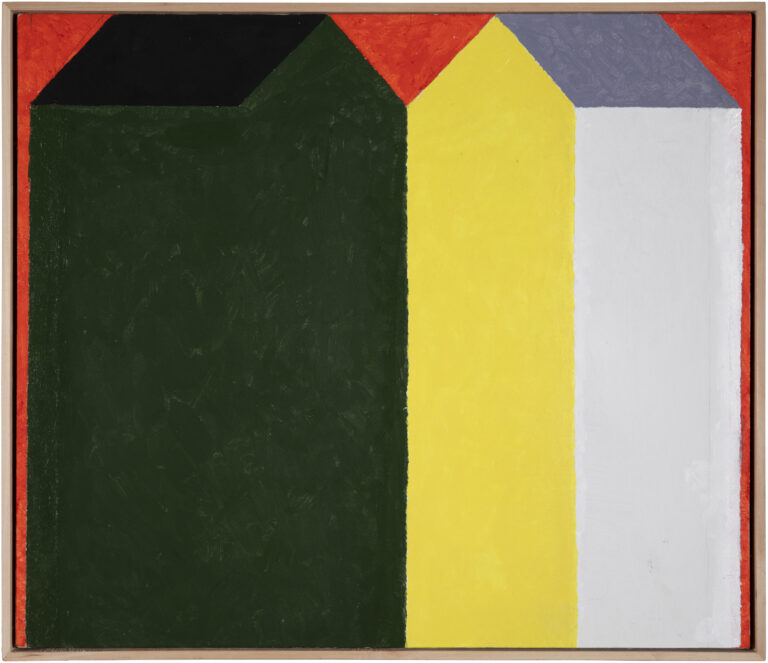Horst Antes
Ich bin das Haus
2 MAY until 21 JUN 2025
Opening – 2 MAy 2025, 6-10 pm
For Gallery Weekend Berlin 2025, Meyer Riegger presents a solo exhibition by painter and sculptor Horst Antes (*1936, Heppenheim), a pioneer of New Figuration in Germany. His work reconciles abstraction with figuration, reinventing ways to depict the human after the Second World War.
Spanning paintings and sculptures from the 1960s to the present day, this comprehensive exhibition traces the evolution of Antes’s work, and includes some pieces that are being shown in public for the first time. The curation reveals both formal and thematic parallels and contrasts, yet throughout, Antes emerges as a ‘painter of colour’ – his distinctive treatment of pigment as material running through his entire oeuvre. While his motifs have changed over the decades, the density of his colour and artistic intent remain constant.

Horst Antes, Porträt 3, 1973/75,
70 x 60 cm, acrylic on canvas
Courtesy the artist and Meyer Riegger
The ‘Kopffüßler’ (Head-Footer), a human figure Antes conceived around 1960, was the first of his monumental, yet never rigid, archetypes: a head with arms attached, often without a torso, resting directly on legs. Art critic Donald Kuspit interprets this figure as ‘the absolute antithesis of the realistic and pseudo-robust Nazi body’. Antes’s visual language also stems from his lifelong engagement with objects and rituals of non-European cultures, which he, as an avid collector and former traveller, has always approached on equal footing.
Contrary to the assumption that his ‘house paintings’ of the 1980s marked a departure from the human figure, art historian Andreas Franzke describes these architectural motifs as figures in themselves – ‘house figures’. The ‘Kopffüßler’ may no longer appear on canvas, yet through their dense chromatic treatment, the house paintings retain a corporeal quality. Antes’s colour is not only dense, but also varied and open – it ‘breathes’. By mixing sawdust into his pigments, he creates a lightmodulating surface structure. His forms, rendered in these ‘tactile’ colours, stretch across the canvas like a skin. Both breath and skin are human attributes, explored by Antes through colour, even in his non-figurative works.

Horst Antes,
2 Häuser, 2024,
60 x 70 cm, acrylic on wood
(Photo: Andrea Lensini)
Courtesy the artist and Meyer Riegger
Many of his house paintings, with their nuanced geometric planes, require no gestural brushwork. When a more dynamic application does occur, it is confined to the predetermined geometry of the walls. In such cases, Antes sometimes calls these works ‘feather houses’ – in contrast to the solidity of architectural form. While his early house paintings were rendered in shades of grey and black, he later expanded his palette. Like all his colours, however, Antes’s black is not a dull monochrome, but richly differentiated. The fundamental role of colour in his artistic development is encapsulated in his own words: ‘Out of lumps of colour, the figure condensed and took shape, acquiring human scale.’
In his ‘date paintings’, Antes records the days of their creation. These works foreground the painterly handwriting of his brushwork. As he repeatedly overlays each day’s numerals with the next, colour and time accumulate until they become illegible. In these paintings, Antes suspends time while making its layered, processual nature visible. Traditionally, including a date with a signature marks a painting’s completion. By transforming the numerals of each day into an autonomous pictorial element, Antes examines the boundaries of an artwork and the visualisation of time’s endlessness. This inquiry is profoundly human, requiring no direct depiction of the human form. In an era where everything is labelled, analysed, stored and measured, Antes’s work stands in contrast. His paintings resist unambiguous interpretation, yet in their immediate presence, and in dialogue with their ‘breathing’ colour, they evoke a sense of what it means to be human.
